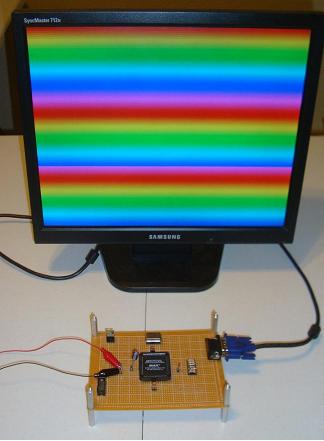An Overview Of The FPGA VGA Resistor DAC
The real goal for anything VGA, DVI or LCD oriented is to be able to display output data to a user in a way that is easy to understand so that they can give some intelligent input. This idea spans across all devices big and small and being able to create a cheap and flexible output controller is invaluable. The advantage of using a CPLD/FPGA with a VGA resistor DAC is that you can expand the functionality of the controller with additional VHDL modules. The CPLD will require more power, but for most simple low-volume hobbyist applications power is not really a concern.

What To Do Now
With a Dynamic multi-color VGA output controller at our hands, we have a lot of opportunity to do some cool things. The next great thing to do would be to build in an external communication module so that another device can control the VGA output via the CPLD. This would allow you to connect anything from and Arduino to a PIC to this CPLD and control what shows up on the screen. Other areas left unexplored are going beyond 512 colors to 16-bit or 24-bit color.
Conclusion
The purpose of this tutorial was to explore using a VGA resistor DAC and it was very successful. 512 unique colors can be created with this system and every single 640x480 pixel on the screen can be controlled by the CPLD. There is still room in the CPLD for more fun, so maybe we can try expanding on this in a future tutorial. For now, complete the tutorial and try to expand upon it in your own way, for your own projects.
If you have any further questions, I implore you...don't be shy, take a look at the forums or ask a question there. I check them out regularly and love getting comments & questions.
The real goal for anything VGA, DVI or LCD oriented is to be able to display output data to a user in a way that is easy to understand so that they can give some intelligent input. This idea spans across all devices big and small and being able to create a cheap and flexible output controller is invaluable. The advantage of using a CPLD/FPGA with a VGA resistor DAC is that you can expand the functionality of the controller with additional VHDL modules. The CPLD will require more power, but for most simple low-volume hobbyist applications power is not really a concern.

What To Do Now
With a Dynamic multi-color VGA output controller at our hands, we have a lot of opportunity to do some cool things. The next great thing to do would be to build in an external communication module so that another device can control the VGA output via the CPLD. This would allow you to connect anything from and Arduino to a PIC to this CPLD and control what shows up on the screen. Other areas left unexplored are going beyond 512 colors to 16-bit or 24-bit color.
Conclusion
The purpose of this tutorial was to explore using a VGA resistor DAC and it was very successful. 512 unique colors can be created with this system and every single 640x480 pixel on the screen can be controlled by the CPLD. There is still room in the CPLD for more fun, so maybe we can try expanding on this in a future tutorial. For now, complete the tutorial and try to expand upon it in your own way, for your own projects.
If you have any further questions, I implore you...don't be shy, take a look at the forums or ask a question there. I check them out regularly and love getting comments & questions.